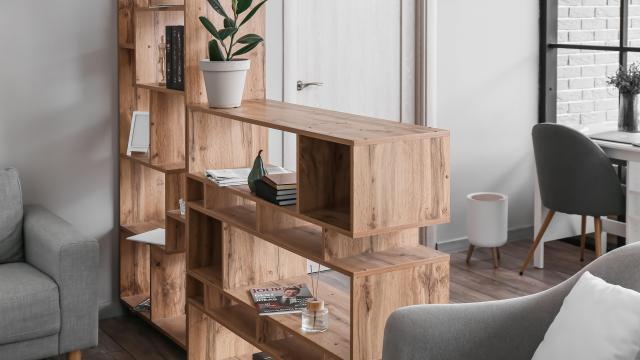If your open floor plan is a little too open, or if you want to carve out some defined space for focused use, room dividers can come in handy. Since most types of room dividers are much simpler and less expensive than a renovation, they’re a good solution for a tight budget. In addition, room dividers can often be versatile, making them a convertible option if you want to change configurations. Here’s a handy guide to some creative and practical room dividers so you can set up your space for less.
Use a folding privacy screen
The classic type of room divider that most people are familiar with is the folding privacy screen. These are good for separating small areas and they’re one of the most versatile options because of their portability—and they’re cost effective, at around $US100 (and up). The downside of a privacy screen is that it will only cover about six feet of linear space.
Use shelving
Using a free-standing bookshelf as a room divider is a good alternative, especially for an office or library space. The nice thing about using a bookshelf is that there are tons of shapes and sizes, allowing access to one or both sides, and a variety of heights and widths to suit your needs. Keep in mind when choosing bookshelves that you’ll need to find one that is designed to stand up without a wall behind it, one that can be anchored to the ceiling, or two bookshelves that you can attach together to widen the base and keep them from toppling. Since there are so many types of shelves, prices vary greatly, but simple shelves will cost between $US50 and $US300 depending on the size. You can choose different configurations of shelves to meet your needs, but they’re not always customizable, so for an odd-shaped space, they might not work.
Use curtains
A curtain room divider is a versatile option that can be used in almost any space. Using a track that attaches to the ceiling, a hanging rod with brackets, or a tension wire system and a curtain tall enough for your space, you can create nearly any shape of divider for a room. Curtain hanging systems will cost between $US35 and $US100 depending on the type and size, and curtain panels will range widely depending on the material and size as well. You can choose opaque curtains to achieve more privacy or less distraction.
Use salvaged windows
For an upcycled room divider, hanging salvaged windows is an option to create a room divider. You’ll need to locate a ceiling joist to attach your hanging hardware to, as well as using well-made hardware to hang the salvaged windows. The total cost of this project can range widely, from around $US20 worth of hardware and some free salvaged windows to around $US300 for salvaged windows from a dealer. It’s important to test your salvaged windows for lead paint—chipping lead paint can be dangerous, especially for children or pets. These dividers have some space between panels and are translucent, so they don’t provide much privacy.
Use wire mesh
Using wire mesh panels hung from the ceiling is a versatile way to create a room divider that can then be set up to hold potted plants using wire hanging hooks, baskets, or to display art. Because the panels can be cut to size, they are a versatile option for creating a room divider. The panels cost between $US75 and $US100 per panel, so it’s an affordable DIY as long as you don’t have a huge amount of linear feet to cover. The downside to this type of room divider is that it’s not opaque, so if you want privacy, it’s not a great fit.

Leave a Reply
You must be logged in to post a comment.